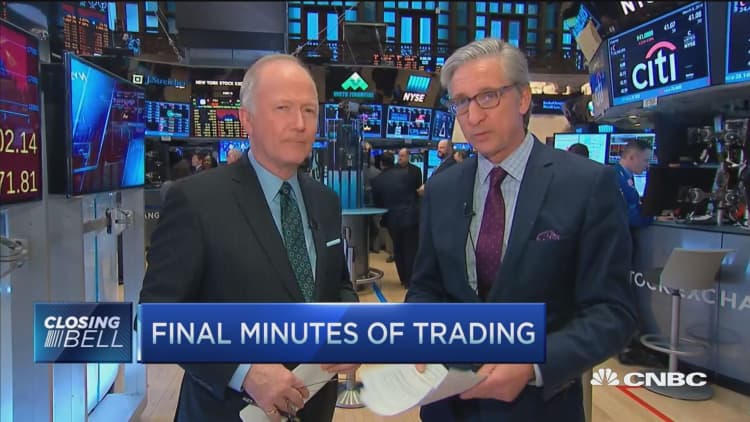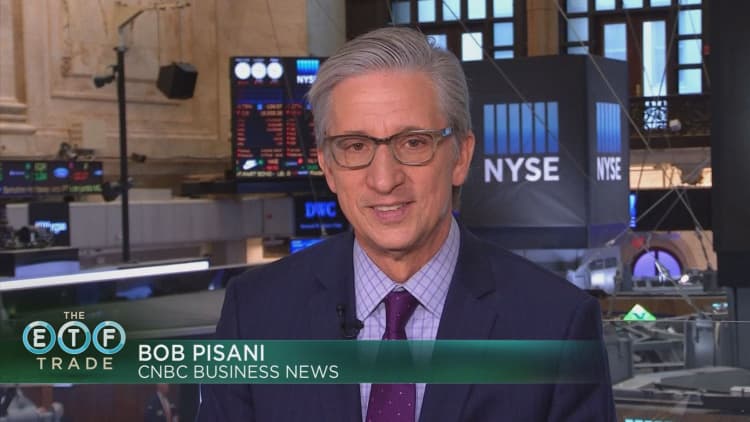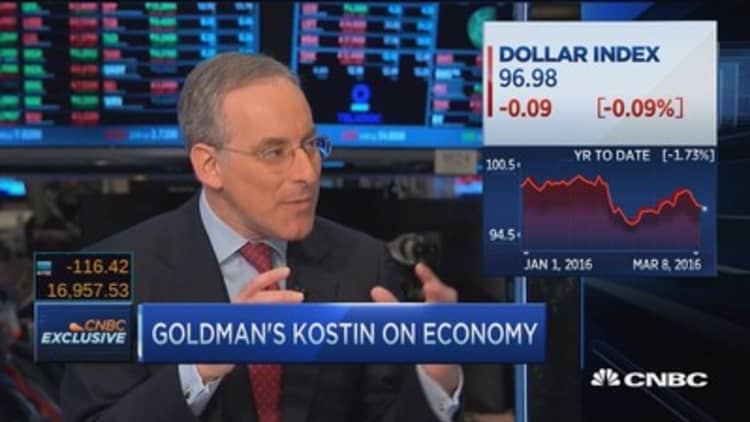




U.S. stocks closed lower Tuesday, as a reversal in oil prices weighed and after weaker-than-expected Chinese trade data renewed concerns about global growth.
"It's not collapsing but certainly profit-taking which is something markets should do when they've had a dramatic move higher," said Quincy Krosby, market strategist at Prudential Financial.
"The question is how much was built on short covering versus new money coming in," she said.
Read More Why stock and bond markets need $50 oil
The Dow Jones industrial average closed about 110 points lower and the S&P 500 ended about 1.1 percent lower after five straight days of gains.
The Russell 2000, which had led much of the recent rally, also snapped a five-day win streak to close 2.4 percent lower.
Energy closed 4 percent lower to lead S&P 500 decliners, followed by a roughly 2 percent decline in materials. U.S. crude oil futures settled down $1.40, or 3.69 percent, at $36.50 a barrel, after trading higher above $38 early in the morning. WTI had its worst daily performance since Feb. 11.
"I think a little bit of profit-taking after the run-up that we've seen. We're in a bit of a news vacuum this week. Earnings are all done. China trade data was shockingly bad. ... The question keeps coming out. How bad is the slowdown in China?" said Ben Pace, chief investment officer at HPM Partners.
The major averages ended near session lows after recovering much of their losses in midday trade as gains in utilities, telecoms and consumer staples offset declines in energy.
"I think investors, they're finding the safety trade a little more attractive here, definitely with bonds higher, utilities higher, stocks off," said John Caruso, senior market strategist at RJO Futures.
Read MoreWhy Main Street isn't partying just yet
McDonald's and Home Depot contributed the most to gains in the Dow, while Caterpillar and Goldman Sachs were the greatest contributors to declines. The index briefly fell more than 150 points in intraday trade and then almost turned higher before closing down about 110 points.
The stock market sell-off "was not as bad as it could have given the drop in oil and the China data overnight," said Jeremy Klein, chief market strategist at FBN Securities.
Treasury yields held lower despite an intraday recovery in stocks, with the at 0.87 percent and the 10-year yield at 1.82 percent.
Read MoreWhile market debates commodities bottom, inflation warnings rise
"I do think the recession scenario is off the table but I think the equity rally we had was one ... fueled by very short-term technical factors," said Jack Ablin, chief investment officer at BMO Private Bank. "The more investors digest the data, whether economic data, corporate profits, or new data, the less they want to own U.S. large-cap stocks. U.S. equities are priced for a global expansion that is not in the cards."
On Monday, WTI settled higher at $37.90 a barrel, its highest level of the year so far. Gains in energy stocks offset declines in tech to help the Dow Jones industrial average and S&P 500 posted their first five straight days of gains since October.
"Oil prices have picked up a lot ... We seem to have found some relief from that," Pace said. We were "near-term overbought. We needed a catalyst (for profit-taking). The catalyst was China."
China's exports fell 25.4 percent year-over-year in February, more than expected and the largest since May 2009, according to Reuters. The trade surplus was at $32.59 billion in February, versus analysts' expectations of a $50.15 billion surplus.
"I do think the numbers suggest the Chinese economy is weaker than the government says it is," said David Kelly, chief global strategist at JPMorgan Funds. "From a global perspective, I'm somewhat encouraged by the NPC. The statements the government have been making to that congress suggests they are very focused on … economic growth at the cost of missing some of their goals."
Analysts largely attributed the sharp drop in the data to a slowdown in business activity around the early February Lunar New Year holidays, Reuters said. Exports for the first two months of the year were still down 17.8 percent and imports off 16.7 percent from the same period last year.
The data also showed jumped 20 percent on year to their highest ever on a daily basis, driven by import quotas and stockpiling.
The Shanghai composite eked out a slight gain, while most Asian equities closed lower. European stocks also ended lower.
In a light week for U.S. economic reports, the key news item is European Central Bank's Thursday meeting.
"We're expecting more stimulus from the ECB and the question is whether investors are going to see that as worries about a global slowdown or something that will propel markets higher," said Chris Gaffney, president, EverBank World Markets.
"The euro is holding $1.10. Certainly traders don't believe the ECB is going to do anything aggressive in terms of pursuing negative rates further," he said.
Read More
The U.S. dollar index was slightly higher, with the euro at $1.10. The yen was at 112.63 yen against the greenback.
As of the close Tuesday, the S&P 500 was about 9 percent above its near-term low hit in intraday trade on Feb.11 and about 7.3 percent below its 52-week intraday high, out of correction territory. The index was still down about 3.2 percent year-to-date.
"I think after this sell-off the next rally is going to tell us more than this sell-off on whether or not this was a really good bottom," said Bruce Bittles, chief investment strategist at RW Baird.
Major averages 10-year performance
The bull market turns seven on Wednesday, and the S&P 500 has risen about 200 percent since it fell below 700 to hit a low on March 9, 2009, during the middle of the financial crisis.
"The encouraging thing is the S&P 500 is still hanging around 2,000 and still within easy striking distance," said JJ Kinahan, chief strategist at TDAmeritrade.
Major U.S. Indexes
The Dow Jones industrial average closed down 109.85 points, or 0.64 percent, at 16,694.10, with Caterpillar the greatest decliner and Microsoft leading advancers.
In its worst day since Feb. 2, the Dow transports closed 2.7 percent lower as JetBlue plunged 9 percent after announcing a 10 to 10.5 percent drop in February's preliminary revenue per available seat mile.
The closed down 22.5 points, or 1.12 percent, at 1,979.26, with energy leading seven sectors lower and utilities the top gainer.
The Nasdaq composite closed down 59.43 points, or 1.26 percent, at 4,648.82.
The CBOE Volatility Index (VIX), widely considered the best gauge of fear in the market, rose above 18.5.
About three stocks declined for every advancer on the New York Stock Exchange, with an exchange volume of 1.1 billion and a composite volume of nearly 4.6 billion in the close.
Read MoreEarly movers: PNRA, AN, DKS, JBLU, IBM, NAV, SJM, URBN, NKE & more
Gold futures for April delivery settled down $1.10 at $1,262.90 an ounce.
—Reuters contributed to this report.
On tap this week:
Wednesday
7 a.m.: Mortgage applications
10 a.m. Wholesale trade
1 p.m. $20 billion 10-year notes auction
Thursday
European Central Bank meeting
8:30 a.m. Weekly claims
10 a.m. Quarterly Services Survey
10:30 a.m.: Natural gas inventories
1 p.m. $12 billion 30-year bonds auction
2 p.m. Federal budget
Friday
8:30 a.m. Import prices
1 p.m.: Oil rig count
*Planner subject to change.
More From CNBC.com:




